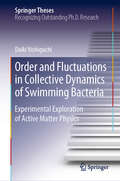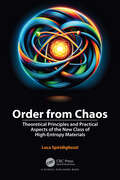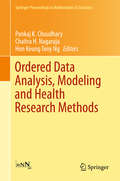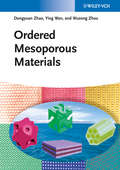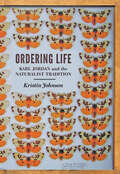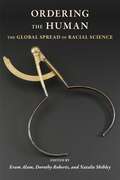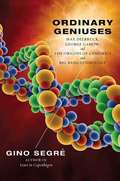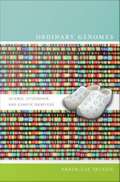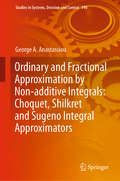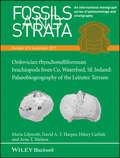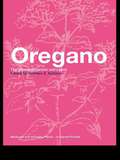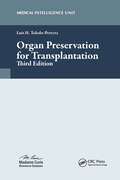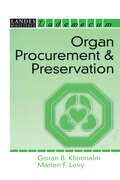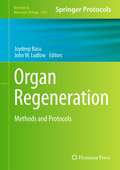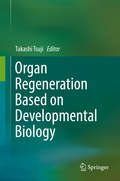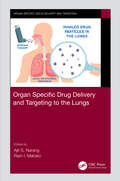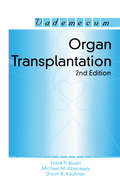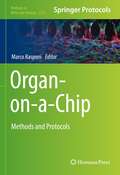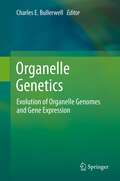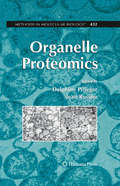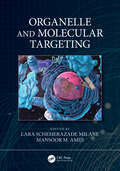- Table View
- List View
Order and Fluctuations in Collective Dynamics of Swimming Bacteria: Experimental Exploration of Active Matter Physics (Springer Theses)
by Daiki NishiguchiThis thesis focuses on experimental studies on collective motion using swimming bacteria as model active-matter systems. It offers comprehensive reviews of state-of-the-art theories and experiments on collective motion from the viewpoint of nonequilibrium statistical physics. The author presents his experimental studies on two major classes of collective motion that had been well studied theoretically. Firstly, swimming filamentous bacteria in a thin fluid layer are shown to exhibit true, long-range orientational order and anomalously strong giant density fluctuations, which are considered universal and landmark signatures of collective motion by many numerical and theoretical works but have never been observed in real systems. Secondly, chaotic bacterial turbulence in a three-dimensional dense suspension without any long-range order as described in the first half is demonstrated to be capable of achieving antiferromagnetic vortex order by imposing a small number of constraints with appropriate periodicity. The experimental results presented significantly advance our fundamental understanding of order and fluctuations in collective motion of motile elements and their future applications.
Order from Chaos: Theoretical Principles and Practical Aspects of the New Class of High-Entropy Materials
by Luca Spiridigliozzi"Order from Chaos: Theoretical Principles and Practical Aspects of the New Class of High-Entropy Materials" offers a comprehensive exploration of High-Entropy Materials, a novel class of materials characterized by complex compositions and unexpected properties. The book delves into the fundamental principles underlying the formation and stabilization of differently structured High-Entropy Ceramics, presenting a detailed analysis of their main physical and technological properties. Moreover, the book discusses the challenges and future prospects of High-Entropy Ceramics as well as their potential applications in various industrial sectors, making it a useful resource for researchers and engineers in the field of advanced ceramics.
Ordered Data Analysis, Modeling and Health Research Methods
by Pankaj K. Choudhary Chaitra H. Nagaraja Hon Keung Tony NgThis volume presents an eclectic mix of original research articles in areas covering the analysis of ordered data, stochastic modeling and biostatistics. These areas were featured in a conference held at the University of Texas at Dallas from March 7 to 9, 2014 in honor of Professor H. N. Nagaraja's 60th birthday and his distinguished contributions to statistics. The articles were written by leading experts who were invited to contribute to the volume from among the conference participants. The volume is intended for all researchers with an interest in order statistics, distribution theory, analysis of censored data, stochastic modeling, time series analysis, and statistical methods for the health sciences, including statistical genetics.
Ordered Mesoporous Materials
by Wuzong Zhou Dongyuan Zhao Ying WanMesoporous materials are a class of molecules with a large and uniform pore size, highly regular nanopores, and a large surface area. This book is devoted to all aspects and types of these materials and describes, in an in-depth and systematic manner, the step-by-step synthesis and its mechanism, as well as the characterization, morphology control, hybridization, and applications, of mesoporous molecular sieves. In so doing, it covers silicates, metal-doped silicates, nonsilicates, and organic-inorganic hybrids.Although the emphasis is on synthesis, the expert authors also discuss characterization and applications, ranging from catalysis and biochemistry to optics and the use of these materials as templates for nanomaterial synthesis. Both the fundamentals and the latest research results are covered, ensuring that this monograph serves as a reference for researchers in and newcomers to the field.
Ordering Life: Karl Jordan and the Naturalist Tradition
by Kristin JohnsonExamines the life of prolific taxonomist Karl Jordan in the context of contemporary events and societal trends.For centuries naturalists have endeavored to name, order, and explain biological diversity. Karl Jordan (1861–1959) dedicated his long life to this effort, describing thousands of new species in the process. Ordering Life explores the career of this prominent figure as he worked to ensure a continued role for natural history museums and the field of taxonomy in the rapidly changing world of twentieth-century science. Jordan made an effort to both practice good taxonomy and secure status and patronage in a world that would soon be transformed by wars and economic and political upheaval. Kristin Johnson traces his response to these changes and shows that creating scientific knowledge about the natural world depends on much more than just good method or robust theory. The broader social context in which scientists work is just as important to the project of naming, describing, classifying, and, ultimately, explaining life.
Ordering Life: Karl Jordan and the Naturalist Tradition
by Kristin JohnsonThis biography of the eminent naturalist explores his life and pioneering work through the rapidly changing world of 19th and 20th century science.For centuries naturalists have endeavored to name, order, and explain biological diversity. Born in 1861, Karl Jordan dedicated his long life to this project, describing thousands of new species in the process. Ordering Life celebrates Jordan’s distinguished career as an entomologist and chronicles his efforts to secure a place for natural history museums and the field of taxonomy.In the face of a changing scientific landscape, Jordan was determined to practice good taxonomy while also pursuing status and patronage—an effort that included close collaboration with the Rothschilds. Biographer Kristin Johnson traces the evolution of Jordan’s work through wars, economic fluctuation, and political upheaval, demonstrating that the broader social context is an essential aspect of naming, describing, classifying, and, ultimately, explaining life.
Ordering the Human: The Global Spread of Racial Science (Race, Inequality, and Health #15)
by Eram Alam, Dorothy Roberts, and Natalie ShibleyModern science and ideas of race have long been entangled, sharing notions of order, classification, and hierarchy. Ordering the Human presents cutting-edge interdisciplinary scholarship that examines the racialization of science in various global contexts, illuminating how racial logics have been deployed to classify, marginalize, and oppress.These wide-ranging essays—written by experts in genetics, forensics, public health, history, sociology, and anthropology—investigate the influence of racial concepts in scientific knowledge production across regions and eras. Chapters excavate the mechanisms by which racialized science serves projects of power and domination, and they explore different forms of resistance. Topics range from skull collecting by eighteenth-century German and Dutch scientists to the use of biology to reinforce notions of purity in present-day South Korea and Brazil. The authors investigate the colonial legacies of the pathologization of weight for the Maori people, the scientific presumption of coronary artery disease risk among South Asians, and the role of racial categories in COVID-19 statistics and responses, among many other cases. Tracing the pernicious consequences of the racialization of science, Ordering the Human shines a light on how the naturalization of racial categories continues to shape health and inequality today.
Ordinary Differential Equations with Applications (Texts in Applied Mathematics #34)
by Carmen ChiconeThis book, developed during 20 years of the author teaching differential equations courses at his home university, is designed to serve as a text for a graduate level course focused on the central theory of the subject with attention paid to applications and connections to other advanced topics in mathematics. Core theory includes local existence and uniqueness, the phase plane, Poincaré-Bendixson theory, Lyapunov and linearized stability, linear systems, Floquet theory, the Grobman–Hartman theorem, persistence of rest points and periodic orbits, the stable and center manifold theorems, and bifurcation theory. This edition includes expanded treatment of deterministic chaos, perturbation theory for periodic solutions, boundary value problems, optimization, and a wide range of their applications. In addition, it contains a formulation and new proof of a theorem on instability of rest points in the presence of an eigenvalue with positive real part, and new proofs of differential inequalities and Lyapunov’s center theorem. New sections present discussions of global bifurcation, the Crandall–Rabinowitz theorem, and Alekseev’s formula. Of particular note is a new chapter on basic control theory, a discussion of optimal control, and a proof of a useful special case of the maximum principle. A key feature of earlier editions, a wide selection of original exercises, is respected in this edition with the inclusion of a wealth of new exercises. Reviews of the first edition:“As an applied mathematics text on linear and nonlinear equations, the book by Chicone is written with stimulating enthusiasm. It will certainly appeal to many students and researchers.”—F. Verhulst, SIAM Review “The author writes lucidly and in an engaging conversational style. His book is wide-ranging in its subject matter, thorough in its presentation, and written at a generally high level of generality, detail, and rigor.”—D. S. Shafer, Mathematical Reviews
Ordinary Geniuses: How Two Mavericks Shaped Modern Science
by Gino SegreA biography of two maverick scientists whose intellectual wanderlust kick-started modern genomics and cosmology. <P><P> Max Delbruck and George Gamow, the so-called ordinary geniuses of Segre's third book, were not as famous or as decorated as some of their colleagues in midtwentieth-century physics, yet these two friends had a profound influence on how we now see the world, both on its largest scale (the universe) and its smallest (genetic code). Their maverick approach to research resulted in truly pioneering science. Wherever these men ventured, they were catalysts for great discoveries. Here Segre honors them in his typically inviting and elegant style and shows readers how they were far from "ordinary". While portraying their personal lives Segre, a scientist himself, gives readers an inside look at how science is done--collaboration, competition, the influence of politics, the role of intuition and luck, and the sense of wonder and curiosity that fuels these extraordinary minds. Ordinary Geniuses will appeal to the readers of Simon Singh, Amir Aczel, and other writers exploring the history of scientific ideas and the people behind them.
Ordinary Genomes: Science, Citizenship, and Genetic Identities
by Karen-Sue TaussigOrdinary Genomes is an ethnography of genomics, a global scientific enterprise, as it is understood and practiced in the Netherlands. Karen-Sue Taussig's analysis of the Dutch case illustrates how scientific knowledge and culture are entwined: Genetics may transform society, but society also transforms genetics. Taussig traces the experiences of Dutch people as they encounter genetics in research labs, clinics, the media, and everyday life. Through vivid descriptions of specific diagnostic processes, she illuminates the open and evolving nature of genetic categories, the ways that abnormal genetic diagnoses are normalized, and the ways that race, ethnicity, gender, and religion inform diagnoses. Taussig contends that in the Netherlands ideas about genetics are shaped by the desire for ordinariness and the commitment to tolerance, two highly-valued yet sometimes contradictory Dutch social ideals, as well as by Dutch history and concerns about immigration and European unification. She argues that the Dutch enable a social ideal of tolerance by demarcating and containing difference so as to minimize its social threat. It is within this particular construction of tolerance that the Dutch manage the meaning of genetic difference.
Ordinary and Fractional Approximation by Non-additive Integrals: Choquet, Shilkret and Sugeno Integral Approximators (Studies in Systems, Decision and Control #190)
by George A. AnastassiouOrdinary and fractional approximations by non-additive integrals, especially by integral approximators of Choquet, Silkret and Sugeno types, are a new trend in approximation theory. These integrals are only subadditive and only the first two are positive linear, and they produce very fast and flexible approximations based on limited data. The author presents both the univariate and multivariate cases. The involved set functions are much weaker forms of the Lebesgue measure and they were conceived to fulfill the needs of economic theory and other applied sciences. The approaches presented here are original, and all chapters are self-contained and can be read independently. Moreover, the book’s findings are sure to find application in many areas of pure and applied mathematics, especially in approximation theory, numerical analysis and mathematical economics (both ordinary and fractional). Accordingly, it offers a unique resource for researchers, graduate students, and for coursework in the above-mentioned fields, and belongs in all science and engineering libraries.
Ordovician rhynchonelliformean brachiopods from Co. Waterford, SE Ireland: Palaeobiogeography of the Leinster Terrane (Fossils and Strata Monograph Series #124)
by David A. Harper Maria Liljeroth Hilary Carlisle Arne T. NielsenA detailed look at the rhynchonelliformean brachiopods of Ireland This publication, Ordovician rhynchonelliformean brachiopods from Co. Waterford, SE Ireland: Palaeobiogeography of the Leinster Terrane, is Number 62 within the Fossils and Strata series. The international Fossils and Strata series features monographs in palaeontology and biostratigraphy with taxonomic descriptions. The series is owned by and published on behalf of The Lethaia Foundation in cooperation with the Scandinavian countries.
Oregano: The genera Origanum and Lippia (Medicinal And Aromatic Plants - Industrial Profiles Ser. #Vol. 25)
by Spiridon E. KintziosOregano: The Genera Origanum and Lippia is an updated analysis of the technical knowledge and market information on the world's most commercially valuable spice. The book treats various aspects of practical significance for the crop's industrialization, such as optimizing germplasm selection and utilization, novel cultivation methods and product pr
Orejas de los animales
by Mary HollandEl sentido del oído es muy importante para la supervivencia de los animales. Provee información vital a los animales que los ayuda a encontrar comida o a escuchar a los depredadores que están listos para atacar. Esta continuación del libro premiado de Mary Holland, de la serie Anatomía de los animales y sus adaptaciones, presenta una amplia variedad de orejas de animales y cómo estos las utilizan. ¿Sabías tú que algunos animales tienen los oídos en las patas? Al igual que los ojos, bocas, patas y colas presentados en libros previos, las orejas de los animales tienen una amplia variedad de formas y tamaños, la combinación perfecta para las necesidades de cada animal. El sentido del oído es muy importante para la supervivencia de los animales. Provee información vital a los animales que los ayuda a encontrar comida o a escuchar a los depredadores que están listos para atacar. Esta continuación del libro premiado de Mary Holland, de la serie Anatomía de los animales y sus adaptaciones, presenta una amplia variedad de orejas de animales y cómo estos las utilizan. ¿Sabías tú que algunos animales tienen los oídos en las patas? Al igual que los ojos, bocas, patas y colas presentados en libros previos, las orejas de los animales tienen una amplia variedad de formas y tamaños, la combinación perfecta para las necesidades de cada animal.
Organ Preservation for Transplantation
by Luis Horacio Toledo-PereyraThe first edition of this book, Basic Concepts in Organ Procurement, Perfusion and Preservation for Transplantation, was published 27 years ago, in 1982 when organ procurement and preservation began to advance in the study of the best ways to preserve organs for transplantation. The second edition, Organ Procurement and Preservation for Transplantation, 2nd Edition, followed 15 years later, in 1997, with the goal of finding common denominators in the best preservation techniques for transplantation. In this current third edition, 11 years after the second edition, similar goals are still pursued of defining the best preservation methods, but there is now more evidence, including results, and new advances have reached publication and are being incorporated into ischemia and reperfusion techniques and organ preservation studies. Many preservation solutions have been introduced, important preservation solution components have been better defined, and improved perfusion methods are being considered, especially for the increasing number of organ donors with non-beating hearts who are being sought for transplantation.This edition (2009) engaged experts in the field of organ preservation to review, update, and rewrite each of the chapters. Crafted in collaboration with Luis H. Toledo-Pereyra, the text is eminently informative and easily understandable. Each solid organ that can be transplanted has an entire chapter devoted to the particular methods of its preservation. One chapter apiece, in other words, features insights on the preservation of the kidney, the liver, the pancreas, the small bowel, the heart, and the heart-lung.The title of the present book has been shortened to better represent its content. Thus, Organ Preservation for Transplantation, 3rd Edition, demonstrates a more accurate depiction of its current status. Nevertheless, the goal of this book remains exactly the same as in the first edition, that is “to analyze the most important aspects of organ procurement, perfusion and preservation for transplantation”.
Organ Procurement and Preservation
by Goran B. KlintmalmThis handbook is a ready reference guide for organ procurement and preservation. Procurement coordinators, surgeons, residents and other health care professionals involved in organ retrieval will find most questions answered that will arise during their participation with these difficult and complex issues.
Organ Regeneration
by John W Ludlow Joydeep BasuTissue engineering and regenerative medicine represents a wide array of cell, biomaterial and cell/biomaterial based approaches focusing on the repair, augmentation, and regeneration of diseases tissues and organs. Organ Regeneration: Methods and Protocols has been assembled in response to the growing interest in organ and tissue regeneration as a means to treat disease. Topics cover methods such as isolation and characterization of cells from selected soft tissues and solid organs, preparation and evaluation of natural and synthetic biomaterial scaffolding, implantation of regenerative constructs within experimental animals, and evaluation of regenerative outcomes by molecular and histological methodologies. Written in the successful Methods in Molecular BiologyTM series format, chapters include introductions to their respective topics, lists of the necessary materials and reagents, step-by-step, readily reproducible protocols, and notes on troubleshooting and avoiding known pitfalls. Authoritative and easily accessible, Organ Regeneration: Methods and Protocols serves as a detailed guide to aid newcomers and seasoned veterans in their developmental and experimental work in tissue engineering and regenerative medicine.
Organ Regeneration
by Takashi TsujiThis book reviews three-dimensional (3D) stem cell culture and proof of concept for organ regeneration. The chapters present studies based on developmental biology but not tissue engineering using bio-degradative scaffolds. The ultimate goal of regenerative therapy, the next generation of regenerative therapy, is to develop fully functioning bioengineered 3D organs that can replace lost or damaged organs following disease, injury, or aging. Next-generation regenerative therapy will consist of organ-replacement regenerative therapy, which aims to reproduce reciprocal epithelial and epithelial interactions and epithelial and mesenchymal interactions that occur during embryogenesis. The book then discusses the generation of several 3D functional organs and organoids such as brain, inner ear, tooth, hair, salivary glands, lacrimal glands, gastrointestinal organs, kidney, liver, and lung. This work will appeal to a wide readership such as medical scientists, developmental biologists, clinicians, and patients. The volume provides valuable information and ideas to form a next-generation field of science.
Organ Regeneration Based on Developmental Biology
by Takashi TsujiThis book reviews three-dimensional (3D) stem cell culture and proof of concept for organ regeneration. The chapters present studies based on developmental biology but not tissue engineering using bio-degradative scaffolds. The ultimate goal of regenerative therapy, the next generation of regenerative therapy, is to develop fully functioning bioengineered 3D organs that can replace lost or damaged organs following disease, injury, or aging. Next-generation regenerative therapy will consist of organ-replacement regenerative therapy, which aims to reproduce reciprocal epithelial and epithelial interactions and epithelial and mesenchymal interactions that occur during embryogenesis. The book then discusses the generation of several 3D functional organs and organoids such as brain, inner ear, tooth, hair, salivary glands, lacrimal glands, gastrointestinal organs, kidney, liver, and lung. This work will appeal to a wide readership such as medical scientists, developmental biologists, clinicians, and patients. The volume provides valuable information and ideas to form a next-generation field of science.
Organ Specific Drug Delivery and Targeting to the Lungs (Organ-specific Drug Delivery and Targeting)
by Ajit S. Narang and Ram I. MahatoOrgan Specific Drug Delivery and Targeting to the Lungs provides up to date information on the multidisciplinary field of particle engineering and drug delivery to the lungs, including advancements of nanotechnology. The text presents a unique, pragmatic focus with case studies, that help translate scientific understanding to practical implementation. In addition to highlighting the successful case studies, it also offers practical advice on watchouts, limitations, and ‘bookend’ boundaries involved in the stages of testing and development. Additional Features Include: Provides an account of particle engineering, discovery, biology, development, and delivery in relation with the advancements of nanotechnology, unlike any previous book. Brings together the leading experts and researchers in the field to critically assess and discuss various topics influencing drug delivery. Highlights the interplay of different scientific disciplines and the balance of requirements that are critical to molecule and product design. With the strategic focus on what matters during new product development, this book provides a guide to understanding and navigating new drug discovery and development for lung targets.
Organ Transplantation
by Frank P. Stuart Michael M. Abecassis Dixon B. KaufmanOrgan transplantation is increasingly complex and at the same time increasingly effective. The lengthening waiting list for cadaver organs now exceeds the supply several-fold. Most practicing physicians encounter only a few transplant recipients during a year of practice. This volume was written as a quick, but comprehensive, reference for medical
Organ-on-a-Chip: Methods and Protocols (Methods in Molecular Biology #2373)
by Marco RasponiThis book provides a collection of microphysiological systems employed for chemical/drug screening and strategies to mimic various physiological conditions. Chapters guide readers through Organ-on-a-Chip( OoC) platforms such as liver, intestine, blood-brain barrier, kidney, vessels, cardiac and skeletal muscles, articular joint, human fat. Additional chapters detail microfabrication technologies used to fabricate OoC devices such as, standard photo- and soft-lithography, techniques to fabricate membranes, and industrial-oriented fabrication methods.Written in the format of the highly successful Methods in Molecular Biology series, each chapter includes an introduction to the topic, lists necessary materials and reagents, includes tips on troubleshooting and known pitfalls, and step-by-step, readily reproducible protocols. Authoritative and cutting-edge, Organ-On-a Chip: Methods and Protocols aims to be a useful practical guide to researches to help further their study in this field.
Organelle Genetics
by Charles E. BullerwellMitochondria and chloroplasts are eukaryotic organelles that evolved from bacterial ancestors and harbor their own genomes. The gene products of these genomes work in concert with those of the nuclear genome to ensure proper organelle metabolism and biogenesis. This book explores the forces that have shaped the evolution of organelle genomes and the expression of the genes encoded by them. Some striking examples of trends in organelle evolution explored here are the reduction in genome size and gene coding content observed in most lineages, the complete loss of organelle DNA in certain lineages, and the unusual modes of gene expression that have emerged, such as the extensive and essential mRNA editing that occurs in plant mitochondria and chloroplasts. This book places particular emphasis on the current techniques used to study the evolution of organelle genomes and gene expression.
Organelle Proteomics
by Delphine Pflieger Jean RossierThis is the first book to examine organelle proteomics in depth. It begins by introducing the different analytical strategies developed and successfully utilized to study organelle proteomes, and detailing the use of multidimensional liquid chromatography coupled to tandem mass spectrometry for peptide sample analysis. Detailed protocols are provided and a section is devoted to methods enabling a global estimate of the reliability of the protein list assigned to an organelle.
Organelle and Molecular Targeting
by Lara Scheherazade Milane and Mansoor M. AmijiWe have surpassed the omics era and are truly in the Age of Molecular Therapeutics. The fast-paced development of SARS-CoV-2 vaccines, such as the mRNA vaccines encoding the viral spike protein, demonstrated the need for and capability of molecular therapy and nanotechnology-based solutions for drug delivery. In record speed, the SARS-CoV-2 viral RNA genome was sequenced and shared with the scientific community, allowing the rapid design of molecular therapeutics. The mRNA vaccines exploit the host cell endoplasmic reticulum to produce viral spike proteins for antigen presentation and recognition by the innate and adaptive immune system. Lipid nanoparticles enable the delivery of the fragile, degradation-sensitive nucleic acid payloads. Molecular-based therapeutics and nanotechnology solutions continue to drive the scientific and medical response to the COVID-19 pandemic as new mRNA, DNA, and protein-based vaccines are developed and approved and the emergency use approved vaccines are rapidly manufactured and distributed throughout the globe. The need for molecular therapies and drug delivery solutions is clear, and as these therapies progress and become more specialized there will be important advancements in organelle targeting. For example, using organelle targeting to direct lipid nanoparticles with mRNA payloads to the endoplasmic reticulum would increase the efficacy of mRNA vaccines, reducing the required dose and therefore the biomanufacturing demand. Likewise, improving the delivery of DNA therapeutics to the nucleus would improve efficacy. Organelles and molecules have always been drug targets, but until recently we have not had the tools or capability to design and develop such highly specific therapeutics. Organelle targeting has far-reaching implications. For example, mitochondria are central to both energy production and intrinsic apoptosis. Effectively targeting and manipulating mitochondria has therapeutic applications for diseases such as myopathies, cancer, neurodegeneration, progerias, diabetes, and the natural aging process. The SARS-CoV-2 vaccines that exploit the endoplasmic reticulum (for mRNA vaccines) and the nucleic translational process (DNA vaccines) attest to the need for organelle and molecular therapeutics. This book covers the status, demand, and future of organelle- and molecularly targeted therapeutics that are critical to the advancement of modern medicine. Organelle and molecular targeting is the drug design and drug delivery approach of today and the future; understanding this approach is essential for students, scientists, and clinicians contributing to modern medicine.
